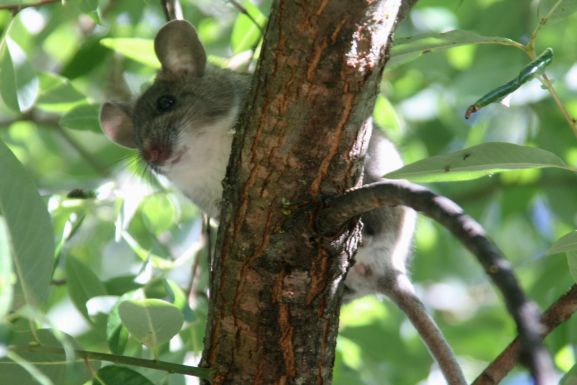Form and Function
The dusky-footed wood rat has adapted to its environment
several different ways. Its preference to being nocturnal, the
way it moves and communicates, and how it chooses to react to
environmental stimuli all contribute to its role in society and
the food chain.
The wood rat is nocturnal for a few reasons. For
one, it escapes most of its predators. Some of its predators
include the bobcats, snakes, and hawks, all of which roam during
the day and sleep at night. This animal still has to be quiet,
however, it can scurry around looking for food without too much
worry of running into its predators around every corner. Another
reason the wood rat is nocturnal is to eliminate its
competition. While most animals are not nocturnal, it has free
range to the vegetation in its area.

Teeth are very important for eating. The muskrat has
sharp incisor teeth in each jaw, which grow throughout their
whole lives (United States Fauna, 2004). These incisor teeth cut
into the vegetation, such as Blackberry, Maul Oak, Valley Oak,
and the Soap plant, while the other teeth are used for chewing
(Encyclopedia of Life). Living in forests, their teeth are
crucial for cutting through sticks to make homes as well. To
learn more about their habitat life, please refer to the
Habitat page.
At night, the wood rat moves around cautiously
through the brushy or forested areas where it lives. In search
for food, the wood rat prefer to run along branches or limbs of
trees in order to eliminate noise. It would rather run on a
ground trail due to if being tracked by a predator, the
predictability of which direction the wood rat is going is
decreased. Also, running on a ground trail is more appealing
because it eliminates noise; for example: running on brush and
crackling leaves creates much more of a disturbance (Bonadio,
2000).
In order to move quickly and quietly, the wood rat
must have a small body. It is about 50 centimeters in length and
weighs about 260 grams (Encyclopedia of Life). Its color of a
light brown coat helps it blend in to its surroundings in the
forest. The claws, used for making homes and scurrying along the
trees, are short, sharp, and come to a point. It’s tail, which
can also determine means of communication, is in between 17 and
22 centimeters long (Encyclopedia of Life).
Communication between wood rats is very specific
depending on their mood. Tolerance between houses is normal,
besides a few arguments now and then. When a wood rat is
fighting with another male, the ears are pulled back tight.
Another indication of a fight is when both animals open and
close their mouths continuously while beat their tails against
the ground. Initiation of the fight occurs when one wood rat
charges the other and biting (Bonadio, 2000). Another way of
communication between these active wood rats is their high
squeaking noise (Donat, 1933).
Also, during mating, the communication between males and
females changes many times. At first, the female is pouncing
around happily, waiting for its mate. The male chooses one
female, lives in their home with them, and then reproduces.
After gestation begins, the female may get annoyed with the
male. If a female gets intolerant, the male leaves and finds a
new female to mate with. Once mated, he will live alone in their
own home of which he built himself.
The way this organism reacts to environmental stimuli
is crucial to its daily survival. Its body shape, means of
communication and travel, and its nocturnal lifestyle help it
maintain a day-to-day routine.
Home
Reproduction
Gabriella Tuminello and Emma Conway of the University of
Wisconsin - La Crosse. Bio 203 - Spring 2014